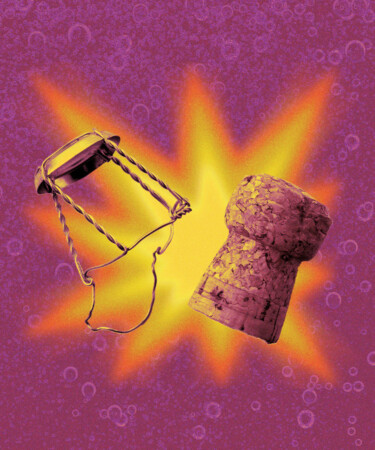For many, the holiday season goes hand in hand with sparkling wine. From Champagne and Crémant to Prosecco, Cava, and American sparklers, a bit of bubbly is sure to make any gathering a festive celebration. But if there’s one thing that can put a damper on the jovial mood, it’s a flying cork hitting your uncle in the eye, thus requiring a trip to your closest emergency room.
To prevent this from happening, the vast majority of sparkling wine producers close their bottles with metal cages, which hold the cork down and prevent the bubbles inside from pushing it out. But far too often, consumers fully remove the cage, giving the cork time to pop out on its own accord. To learn more about the importance of keeping the cage on a bottle of sparkling wine while opening, VinePair chatted with Ren Peir, a wine educator and sommelier at NYC Lower East Side wine bar Somm Time.
“If you remove the cage fully, you might accidentally lose control of the cork, in which case it can totally go flying out of the bottle,” Peir explains. “Moreover, the cage also provides some extra grip which makes opening the bottle easier.”
To protect yourself and others, instead of removing the cage entirely, simply twist open its closure loop with approximately six half turns before proceeding any further. From there, Peir says, you should twist the bottle to remove the cork rather than twisting the cork itself.
“I used to twist open sparkling wines with the hand holding the cork and I never knew why I’d have violent explosions that surprised the hell out of me,” she says. “Oh, right, it’s because I was removing the hand holding back all the CO2 pressure in the bottle.”
For the safest opening, Peir recommends tilting your bottle of bubbly roughly 45 degrees away from your body while holding the cork and cage firmly. Then, twist from the bottom of the bottle, allowing the cork to ease out while the hand holding the stopper remains steady. “As you twist the bottle, you’ll feel the cork loosening and you can gauge how much you want to press back to open the bottle at the noise level you want,” she explains. “Less pressing back will equal a more delightful pop! Volia.”
While it’s far more likely that removing the cage before uncorking will cause you to lose a significant amount of liquid rather than sending someone to the hospital, no one really wants to deal with any sacrificed Champagne, either. So this holiday season and for every holiday season to come, make sure to keep your loved ones — and your bubbly — safe from any flying corks by keeping the cage on when opening the bottle.
*Image retrieved from Lukas Gojda via stock.adobe.com
